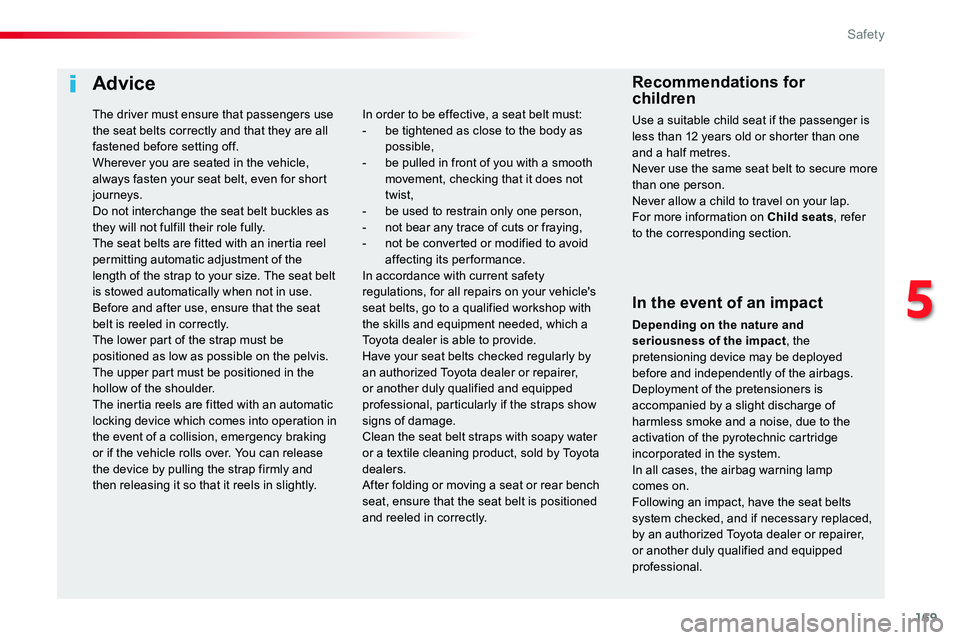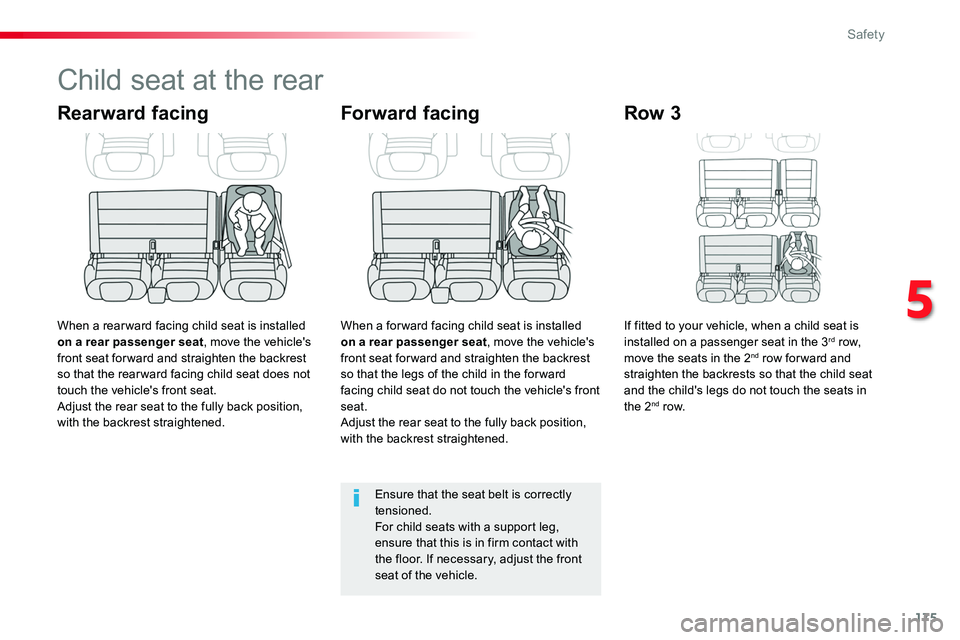Page 168 of 516
168
Seat belt warning lamps
If your vehicle has individual front seats:1. Driver's seat belt not fastened / unfastened warning lamp in the instrument panel.2. Front passenger seat belt not fastened / unfastened warning lamp.
From about 12 mph (20 km/h) and for two minutes, the warning lamps(s) flash accompanied by an audible signal. Beyond these two minutes, the warning lamps remain on if the driver or front passenger do not fasten their seat belt(s).
On switching on the ignition, a warning lamp comes on in the instrument panel if the corresponding seat belt is not fastened or is unfastened.
If your vehicle has a 2-seat bench front seat:A. Outer (driver) seat belt not fastened / unfastened warning lamp.B. Centre and/or outer seat belt not fastened warning lamp.
When the ignition is switched on, the warning lamp A comes on if the driver's seat belt is not fastened or unfastened.The warning lamp B comes on if the centre and/or an outer seat belt is unfastened.
Safety
Page 169 of 516

169
Advice
In the event of an impact
Depending on the nature and seriousness of the impact, the pretensioning device may be deployed before and independently of the airbags. Deployment of the pretensioners is accompanied by a slight discharge of harmless smoke and a noise, due to the activation of the pyrotechnic cartridge incorporated in the system.In all cases, the airbag warning lamp comes on.Following an impact, have the seat belts system checked, and if necessary replaced, by an authorized Toyota dealer or repairer, or another duly qualified and equipped professional.
In order to be effective, a seat belt must:- be tightened as close to the body as possible,- be pulled in front of you with a smooth movement, checking that it does not twist,- be used to restrain only one person,- not bear any trace of cuts or fraying,- not be converted or modified to avoid affecting its performance.In accordance with current safety regulations, for all repairs on your vehicle's seat belts, go to a qualified workshop with the skills and equipment needed, which a Toyota dealer is able to provide.Have your seat belts checked regularly by an authorized Toyota dealer or repairer, or another duly qualified and equipped professional, particularly if the straps show signs of damage.
Clean the seat belt straps with soapy water or a textile cleaning product, sold by Toyota dealers.After folding or moving a seat or rear bench seat, ensure that the seat belt is positioned and reeled in correctly.
Recommendations for children
Use a suitable child seat if the passenger is less than 12 years old or shorter than one and a half metres.Never use the same seat belt to secure more than one person.Never allow a child to travel on your lap.For more information on Child seats, refer to the corresponding section.
The driver must ensure that passengers use the seat belts correctly and that they are all fastened before setting off.Wherever you are seated in the vehicle, always fasten your seat belt, even for short journeys.Do not interchange the seat belt buckles as they will not fulfill their role fully.The seat belts are fitted with an inertia reel permitting automatic adjustment of the length of the strap to your size. The seat belt is stowed automatically when not in use.Before and after use, ensure that the seat belt is reeled in correctly.The lower part of the strap must be positioned as low as possible on the pelvis.The upper part must be positioned in the hollow of the shoulder.The inertia reels are fitted with an automatic locking device which comes into operation in
the event of a collision, emergency braking or if the vehicle rolls over. You can release the device by pulling the strap firmly and then releasing it so that it reels in slightly.
5
Safety
Page 173 of 516

173
Sit in a normal upright position.Wear a correctly adjusted seat belt.Do not leave anything between the occupants and the airbags (a child, pet, object...), nor fix or attach anything close to the inflation trajectory of the airbags; this could cause injuries during their deployment.Never modify the original definition of your vehicle, particularly in the area directly around the airbags.After an accident or if the vehicle has been stolen or broken into, have the airbag systems checked.All work on the airbag system must be carried out by an authorized Toyota dealer or repairer, or another duly qualified and equipped professional.Even if all of the precautions mentioned are observed, a risk of injury or of minor burns to the head, chest or arms when an airbag is deployed cannot be ruled out.
Lateral airbags
Use only approved covers on the seats, compatible with the deployment the lateral airbags. For information on the range of seat covers suitable for your vehicle, you can contact an authorized Toyota dealer or repairer, or another duly qualified and equipped professional.For more information on Accessories, refer to the corresponding section.Do not fix or attach anything to the seat backs (clothing...). This could cause injury to the chest or arms if the lateral airbag is deployed.Do not sit with the upper part of the body any nearer to the door than necessary.
The bag inflates almost instantly (within a few milliseconds) then deflates within the same time discharging the hot gas via openings provided for this purpose.
Front airbags
Do not drive holding the steering wheel by its spokes or resting your hands on the centre part of the wheel.Passengers must not place their feet on the dashboard.Do not smoke as deployment of the airbags can cause burns or the risk of injury from a cigarette or pipe.Never remove or pierce the steering wheel or hit it violently.Do not fit or attach anything to the steering wheel or dashboard, this could cause injuries with deployment of the airbags.
Advice
For the airbags to be fully effective, observe the safety recommendations below:
The vehicle's front door panels include side impact sensors.A damaged door or any unauthorised or
incorrectly executed work (modification or repair) on the front doors or their interior trim could compromise the operation of these sensors - Risk of malfunction of the lateral airbags!Such work must only be done by an authorized Toyota dealer or repairer, or another duly qualified and equipped professional.
5
Safety
Page 174 of 516
174
General points relating to child seats
For maximum safety, please observe the following recommendations:- in accordance with European regulations, all children under the age of 12 or less than one and a half metres tall must travel in approved child seats suited to their weight, on seats fitted with a seat belt or ISOFIX mountings*,- statistically, the safest seats in your vehicle for carr ying children are the rear seats,- a child weighing less than 9 kg must travel in the rear ward facing position both in the front and in the rear.
Toyota recommends that children should travel on the rear seats of your vehicle:- rearward facing up to the age of 3,
- forward facing over the age of 3.
Although one of Toyota's main criteria when designing your vehicle, the safety of your children also depends on you.
* The regulations on carrying children are specific to each country. Refer to the legislation in force in your country.
Safety
Page 175 of 516

175
Child seat at the rear
Rearward facing
When a rear ward facing child seat is installed on a rear passenger seat, move the vehicle's front seat for ward and straighten the backrest so that the rear ward facing child seat does not touch the vehicle's front seat.Adjust the rear seat to the fully back position, with the backrest straightened.
Forward facing
When a for ward facing child seat is installed on a rear passenger seat, move the vehicle's front seat for ward and straighten the backrest so that the legs of the child in the for ward facing child seat do not touch the vehicle's front seat.Adjust the rear seat to the fully back position, with the backrest straightened.
Ensure that the seat belt is correctly tensioned.For child seats with a support leg, ensure that this is in firm contact with the floor. If necessary, adjust the front seat of the vehicle.
Row 3
If fitted to your vehicle, when a child seat is installed on a passenger seat in the 3rd row, move the seats in the 2nd row for ward and straighten the backrests so that the child seat and the child's legs do not touch the seats in the 2nd row.
5
Safety
Page 176 of 516
176
Passenger seat in the fully back and highest position.
Rearward facing
Child seat at the front*
Forward facing
Ensure that the seat belt is correctly tensioned.For child seats with a support leg, ensure that the support leg is in firm and stable contact with the floor. If necessary, adjust the passenger seat.
When a rear ward facing child seat is installed on the front passenger seat, adjust the seat to the fully back and highest position, with the backrest straightened.The passenger's front airbag must be deactivated. Otherwise, the child risks being seriously injured or killed if the airbag is deployed.
When a for ward facing child seat is installed on the front passenger seat, adjust the vehicle's seat to the fully back and highest position with the seat backrest straightened and leave the passenger's front airbag activated.
* Refer to the legislation in force in your country before carrying your child in this seating position.
Safety
Page 180 of 516
180
Child seats recommended by Toyota
Toyota offers a range of child seats which are secured using a three point seat belt.
Group 0+: from bir th to 13 kg
L1 "TOYOTA GO + BABYSAFE PLUS" Installed rearward facing.
Safety
Page 182 of 516
182
In line with European legislation, this table indicates the options for installing child seats secured using a seat belt and universally approved (a) for the weight of the child and the seat in the vehicle.
Seat
Weight of the child and indicative age
Under 13 kg (groups 0 (b) a n d 0 +)Up to approx 1 year
From 9 to 18 kg (group 1)1 to 3 years approx
From 15 to 25 kg (group 2)3 to 6 years approx
From 22 to 36 kg (group 3)6 to 10 years approx
Cab / Row 1 (c) (d)
With individual seat, passenger seatUUUU
With bench seat, outer seatUUUU
With bench seat, centre seatXXXX
Row 2 (e)
Left-hand outer seat-*
Centre seat-*
Right-hand outer seat-*
Locations for child seats secured with
a seat belt
* Submitted for type approval.
Safety